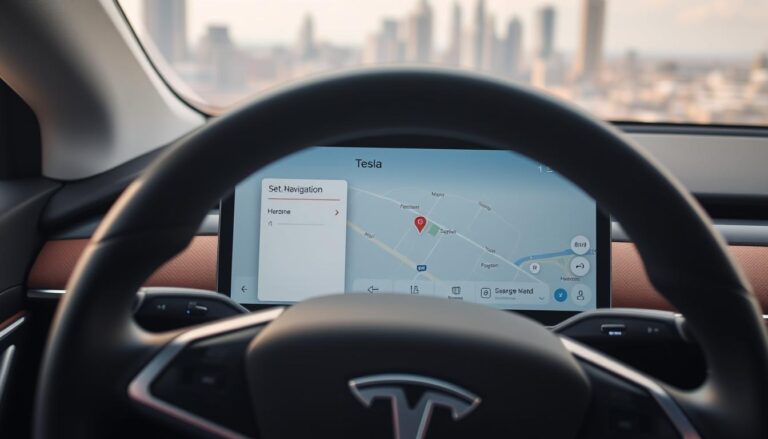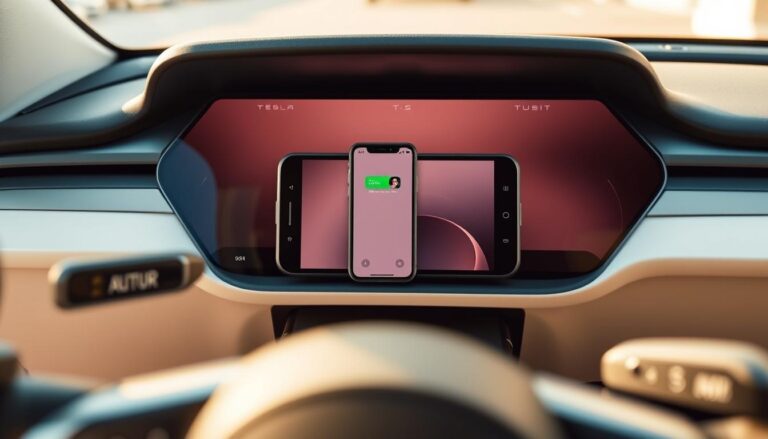Experiencing issues with your Tesla’s regenerative braking system can be frustrating. Regenerative braking is a crucial feature that helps recharge the battery and improve overall efficiency. When it’s not working correctly, it can lead to reduced range and performance.
If you’re facing regenerative braking not working issues, it’s essential to identify the root cause. This article will guide you through the possible reasons behind the malfunction and provide you with practical troubleshooting steps to resolve the issue.
Key Takeaways
- Understand the common causes of Tesla regenerative braking issues
- Learn how to troubleshoot regenerative braking problems
- Discover the steps to fix regenerative braking not working issues
- Get tips on maintaining your Tesla’s regenerative braking system
- Find out when to seek professional help for regenerative braking issues
Understanding Tesla’s Regenerative Braking System
Tesla’s advanced regenerative braking system plays a vital role in improving range and reducing wear on brakes. This sophisticated technology is integral to the efficiency and performance of Tesla vehicles.
How Regenerative Braking Works in Tesla Vehicles
Regenerative braking in Tesla vehicles captures kinetic energy and converts it into electrical energy, which is then stored in the battery. This process occurs when the vehicle decelerates or brakes, utilizing the electric motor as a generator to recharge the battery.
Benefits of Regenerative Braking for Range and Brake Life
The benefits of regenerative braking include increased vehicle range and extended brake life. By recovering kinetic energy, Tesla vehicles can travel further on a single charge. Additionally, regenerative braking reduces the wear on brake pads, resulting in lower maintenance costs over time.
- Enhanced vehicle efficiency
- Improved range
- Reduced brake wear
Common Signs That Your Tesla’s Regenerative Braking Is Not Working
Regenerative braking is a critical feature in Tesla vehicles, and there are several signs that can indicate it’s not working as it should. If you’re experiencing issues with your Tesla’s regenerative braking, you’ll likely notice one or more of the following symptoms.
Reduced Deceleration When Releasing the Accelerator
One of the primary indicators of a malfunctioning regenerative braking system is reduced deceleration when you release the accelerator pedal. Normally, when you take your foot off the accelerator, the vehicle should slow down due to regenerative braking. If this doesn’t happen, or if the deceleration is significantly less than expected, it could be a sign that the regenerative braking system is not functioning correctly.
Some common experiences that may indicate reduced deceleration include:
- The vehicle doesn’t slow down as expected when releasing the accelerator.
- A noticeable decrease in the ‘one-pedal’ driving experience.
Changes in Energy Consumption and Range
Another sign that your Tesla’s regenerative braking might not be working is changes in energy consumption and range. Regenerative braking helps recharge the battery, thereby improving the vehicle’s efficiency and range. If the regenerative braking system is malfunctioning, you might notice:
- An unexpected decrease in the vehicle’s range.
- An increase in energy consumption, as indicated by the vehicle’s energy consumption graphs.
If you observe any of these signs, it’s essential to investigate further to determine the cause of the issue.
Tesla Regenerative Braking Not Working: Common Causes
Understanding the common causes behind Tesla regenerative braking not working is crucial for troubleshooting and resolving the issue. The regenerative braking system is a complex component of Tesla vehicles, and its failure can be attributed to various factors.
Battery Temperature Issues
Battery temperature plays a significant role in the functioning of Tesla’s regenerative braking system. Extreme temperatures, either too high or too low, can affect the battery’s performance and, consequently, the regenerative braking. For instance, in very cold temperatures, the battery’s efficiency may decrease, reducing the effectiveness of regenerative braking.
Battery Charge Level Limitations
The charge level of the battery is another critical factor. When the battery is fully charged or nearly fully charged, Tesla’s system may limit regenerative braking to prevent overcharging. This is a protective mechanism to ensure the longevity of the battery.
Software Glitches and Updates
Software issues can also impact the regenerative braking system. Outdated software or glitches within the system can cause malfunctions. Regular software updates are essential to maintain the optimal performance of Tesla’s regenerative braking.
| Cause | Description | Potential Solution |
|---|---|---|
| Battery Temperature Issues | Extreme temperatures affect battery performance. | Park in shaded areas or use thermal management systems. |
| Battery Charge Level Limitations | Regenerative braking is limited when the battery is fully charged. | Avoid frequent full charging; keep between 20% and 80% charged. |
| Software Glitches and Updates | Outdated software or glitches cause malfunctions. | Regularly update Tesla software to the latest version. |
Weather-Related Factors Affecting Regenerative Braking
Understanding how weather affects regenerative braking can help Tesla owners optimize their vehicle’s performance. Weather conditions, particularly cold weather, play a significant role in the efficiency of regenerative braking.
Cold Weather Effects on Regenerative Braking
Cold weather can significantly impact the performance of Tesla’s regenerative braking system. Low temperatures reduce the battery’s ability to accept charge, thereby limiting the effectiveness of regenerative braking.

How to Prepare Your Tesla for Winter Driving
Preparing your Tesla for winter driving is crucial to maintaining the efficiency of regenerative braking. Here are some tips to help you prepare.
Battery Preconditioning Techniques
Preconditioning your Tesla’s battery before driving in cold weather can improve regenerative braking efficiency. This involves heating the battery to its optimal temperature before driving.
Garage Storage Benefits
Storing your Tesla in a garage during extreme cold weather can help maintain the battery’s temperature, thereby supporting regenerative braking efficiency.
| Winter Preparation Tip | Benefit |
|---|---|
| Battery Preconditioning | Improves regenerative braking efficiency |
| Garage Storage | Maintains battery temperature |
Troubleshooting Tesla Regenerative Braking Issues
Troubleshooting regenerative braking issues in Tesla vehicles requires a systematic approach. By checking the regenerative braking settings, performing a soft reset, and using the Tesla app, owners can diagnose and potentially resolve problems.
Checking Regenerative Braking Settings
The first step in troubleshooting regenerative braking issues is to check the settings. Ensure that regenerative braking is enabled in your Tesla’s settings. To do this, navigate to the “Controls” menu, then select “Braking” and verify that “Regenerative Braking” is turned on. If it’s already enabled, try toggling it off and on to reset the setting.
Performing a Soft Reset of Your Tesla
A soft reset can resolve many issues, including problems with regenerative braking. This process restarts the vehicle’s systems without affecting any saved settings.
How to Reset Model 3 and Model Y
For Model 3 and Model Y, press and hold both scroll buttons on the steering wheel until the screen turns off, then release. This will restart the system.
How to Reset Model S and Model X
For Model S and Model X, press and hold the two scroll buttons on the steering stalk until the screen turns off, then release. This action will soft reset the vehicle’s computer.
As noted in a discussion on regenerative braking issues, a soft reset can often resolve the problem. “After performing a soft reset, my regenerative braking started working again,” reported one Tesla owner.
Using the Tesla App to Diagnose Problems
The Tesla app can be a valuable tool in diagnosing regenerative braking issues. Open the app, go to the “Controls” section, and check if the regenerative braking setting is displayed correctly. If the app indicates a problem or if the setting is not reflecting the changes you made in the vehicle, it may indicate a software or connectivity issue.
By following these steps, Tesla owners can troubleshoot regenerative braking issues effectively. If problems persist, it may be necessary to visit a Tesla service center for further assistance.
Step-by-Step Solutions to Fix Regenerative Braking Problems
Resolving issues with Tesla’s regenerative braking system involves a series of simple troubleshooting steps. By following these steps, Tesla owners can effectively address and fix regenerative braking problems.
Preconditioning Your Battery Before Driving
Preconditioning your Tesla’s battery before driving can significantly impact the performance of regenerative braking. This process involves preparing your battery for optimal operating conditions, which can be done by turning on the climate control system while your car is still plugged into the charger. This simple step can improve regenerative braking efficiency.
Adjusting Regenerative Braking Settings
Adjusting the regenerative braking settings can also help resolve issues. Tesla vehicles allow owners to adjust the level of regenerative braking through the settings menu. Choosing the right level of regeneration can enhance the overall driving experience and fix problems related to regenerative braking.
Installing the Latest Software Updates
Ensuring your Tesla is running the latest software is crucial. Software updates often include fixes for known issues, including those related to regenerative braking.
Checking for Available Updates
To check for updates, navigate to the software update section in your Tesla’s settings menu. If an update is available, follow the on-screen instructions to download and install it.
Troubleshooting Update Failures
If an update fails, try restarting your vehicle and attempting the update again. Persistent issues may require contacting Tesla support.
| Step | Description | Benefit |
|---|---|---|
| 1. Precondition Battery | Prepare battery for optimal conditions | Improved Regenerative Braking Efficiency |
| 2. Adjust Regenerative Braking Settings | Choose the right level of regeneration | Enhanced Driving Experience |
| 3. Install Software Updates | Keep your Tesla’s software up-to-date | Fixes for Known Issues |

When to Contact Tesla Service for Regenerative Braking Issues
Tesla owners should be aware of the signs that indicate it’s time to contact Tesla service for regenerative braking issues. While some problems can be resolved through troubleshooting, others may require professional assistance.
Warning Signs of Serious Problems
If you notice any of the following symptoms, it’s essential to contact Tesla service:
- Persistent loss of regenerative braking functionality
- Unusual noises when applying the brakes
- Warning messages on the dashboard related to regenerative braking
Ignoring these signs can lead to more severe problems, potentially compromising your safety on the road.
What to Expect During a Service Appointment
When you contact Tesla service for regenerative braking issues, you can expect a thorough diagnosis of the problem. Tesla’s service team will:
| Service Step | Description |
|---|---|
| Diagnostic Check | Identify the root cause of the regenerative braking issue |
| Software Updates | Install the latest software to resolve known issues |
| Hardware Inspection | Inspect brake hardware for any signs of wear or damage |
By understanding what to expect during a service appointment, you can be better prepared to address regenerative braking issues with Tesla service.
Conclusion
In conclusion, addressing Tesla regenerative braking issues requires understanding the underlying causes and applying the right fixes. By recognizing the signs of malfunctioning regenerative braking, such as reduced deceleration or changes in energy consumption, you can take prompt action to resolve the problem.
The common causes of regenerative braking issues, including battery temperature problems, software glitches, and weather-related factors, can be effectively troubleshooted using the steps outlined in this article. By checking regenerative braking settings, performing a soft reset, and installing the latest software updates, you can often resolve the issue.
For persistent problems, knowing when to contact Tesla service is crucial. By being aware of the warning signs of serious issues and understanding what to expect during a service appointment, you can ensure your Tesla vehicle receives the necessary attention. By following this troubleshooting summary, you can effectively address regenerative braking issues and maintain your Tesla’s optimal performance.
FAQ
Why is my Tesla’s regenerative braking not working?
Regenerative braking issues in Tesla vehicles can be caused by various factors, including battery temperature issues, battery charge level limitations, and software glitches.
How do I know if my Tesla’s regenerative braking is not working properly?
Common signs include reduced deceleration when releasing the accelerator and changes in energy consumption and range.
Can cold weather affect my Tesla’s regenerative braking?
Yes, cold weather can impact regenerative braking performance. Preconditioning your battery before driving and storing your Tesla in a garage can help mitigate these effects.
How do I troubleshoot regenerative braking issues in my Tesla?
Start by checking regenerative braking settings, performing a soft reset, and using the Tesla app to diagnose problems.
What are the benefits of regenerative braking for my Tesla’s range and brake life?
Regenerative braking enhances your vehicle’s efficiency by capturing kinetic energy and converting it into electrical energy, thereby extending your range and prolonging brake life.
How do I adjust regenerative braking settings in my Tesla?
You can adjust regenerative braking settings through your Tesla’s settings menu, allowing you to customize the level of regenerative braking to suit your driving preferences.
When should I contact Tesla Service for regenerative braking issues?
If you notice warning signs of serious problems, such as unusual noises or vibrations, it’s recommended to schedule a service appointment with Tesla.
How do software updates affect regenerative braking in Tesla vehicles?
Software updates can improve regenerative braking performance by addressing software glitches and enhancing system functionality.


